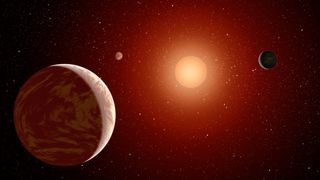Astronomers have discovered a “super-Earth” orbiting a red dwarf star just 37 light-years from our solar system.
That exoplanet Ross 508 b is overflying its parent star’s habitable zone, the region where surface temperatures are suitable for supporting the existence of liquid water, a key component of life. About four times the mass of Earth, the newly discovered exoplanet was spotted using a new infrared monitoring technique. This super-Earth’s close proximity to our planet means it’s ripe for atmospheric surveys that could help researchers determine if life might exist near low mass Stars.
“That the very first planet discovered using this new method is so temptingly close to the habitable zone seems too good to be true and bodes well for future discoveries,” said team leader and professor Bun’ei Sato from Tokyo Institute of Technology in an opinion.
Related: These 10 Super Extreme Exoplanets Are Out of This World
Red dwarfs like Ross 508, which are about one-fifth the mass of the Sun, are small stars that make up about three-fourths of all stars in our galaxy Milky Way. These stars are particularly common in the region around our solar system, making red dwarf stars and their systems ideal targets for searching for extrasolar planets solar system and the study of possible life elsewhere in the universe.
Because red dwarfs are small, they are cool with temperatures between 2,000 and 3,500 Kelvin. Their relatively low temperatures make them dimmer in visible light compared to larger stars, meaning astronomers must study them in the infrared.
To that end, the Astrobiology Center in Japan has developed an infrared observation instrument called the InfraRed Doppler Instrument (IRD) to be mounted on the Subaru telescope in Hawaii. Using this instrument – the world’s first high-precision infrared spectrograph for an 8-meter-class telescope – the astronomers went in search of signs of planets around red dwarf stars.
In particular, the researchers looked for the telltale “wobble” that an exoplanet causes in the orbit of its parent star; The wobble is registered as a tiny shift in the wavelength of light from the star as it moves toward and away from the star Earth.
The discovery of Ross 508 b marks the first success for the project, officially named the IRD Subaru Strategic Program (IRD-SSP).
“It’s been 14 years since development of IRD began,” Sato said. “We continued our development and research in hopes of finding a planet just like Ross 508 b.”
Ross 508 b, only the third planet found around such a low-mass star, has an average distance from its parent star of just one twentieth Distance between earth and sun. The astronomers who spotted it believe the planet’s highly elliptical orbit carries it into Ross 508’s habitable zone every 11 days.
“Ross 508 b is the first successful detection of a super-Earth using only near-infrared spectroscopy,” Subaru telescope researcher Hiroki Harakawa said in the statement. “Previously, for the detection of low-mass planets like super-Earths, near-infrared observations alone were not accurate enough, and verification by high-precision line-of-sight velocity measurements in visible light was required.” (Although super-Earths are larger than our own planet, most exoplanets Scientists are currently finding that they are much larger.)
Harakawa added that the study, for which he was the lead author, shows that even acting alone, IRD-SSP is capable of planetary discovery. He said the work particularly demonstrates the advantage of IRD-SSP in its ability to detect planets with high precision, even near late-type red dwarfs that are too faint to be observed with visible light.
The team’s research was published in the journal on June 30 Publication of the Astronomical Society of Japan (PASJ).
follow us on twitter @spacedotcom and further Facebook.
#planet #superearth #hurtles #habitable #zone #red #dwarf #star



Leave a Comment